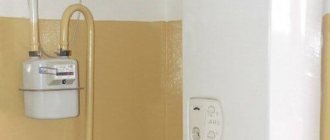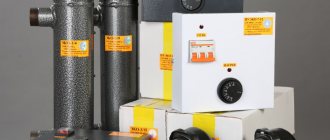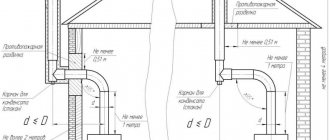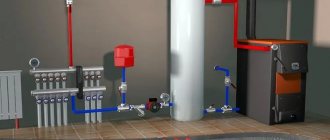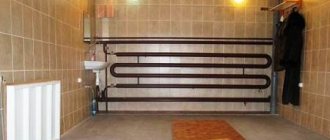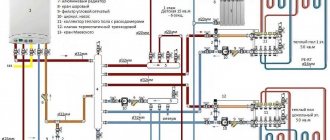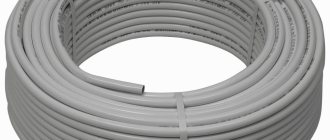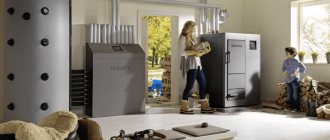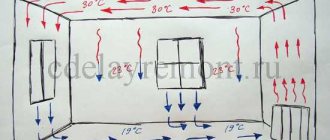The constant increase in tariffs for housing and communal services causes a natural desire among residents of apartment buildings to install independent individual heating systems. Modern construction provides for zoned floor-to-floor and then apartment-by-apartment heat supply at the design stage.
The original solution for wiring the heating in the floor of the apartment hides the system of distribution pipelines, preserving the aesthetic appearance of the rooms. The independence of installation schemes for process pipes at individual facilities makes it possible to create an individual project for a heat supply scheme and install various heating devices.
Installation of apartment heating
Autonomous heating in an apartment
How relevant is this method of maintaining a comfortable temperature in an apartment? At first glance, it seems that the costs of purchasing equipment, installing and maintaining it will significantly exceed the costs compared to central heating. However, by making simple calculations, you can make sure that gas apartment heating will compensate for the initial costs over three to five operating seasons.
To ensure the objectivity of these conclusions, one should consider the positive and negative aspects of installing an autonomous system.
Advantages of apartment heating:
- The ability to set a comfortable temperature level in the room yourself. For central heating, it is possible to implement such a function - it requires the installation of a special meter, which must be approved by many authorities;
- Reduced operating costs for coolant. On average, apartment heating systems cost residents 40-50% less than a central system;
- Complete independence from the work of the heat supply management company. This applies to scheduled and emergency repairs, and non-compliance of the coolant temperature with standards.
The main negative point for any apartment heating system is the high initial cost of purchasing equipment and the complexity of its installation. In addition, to disconnect from the central system and install an autonomous one, it is necessary to obtain the appropriate permits. All concerns about routine maintenance and equipment repairs also fall on the shoulders of the apartment owner.
Block boiler room in a residential building
The situation for this type of heating system looks much better. The funds are invested because construction companies must deliver the house, and without a heating system this will not be possible. Since heating networks place high demands on heating systems, they have to meet them. The efficiency is quite high, since there is no need to transport heat. But as far as property is concerned, a question arises. On the one hand, the owners are all the owners of apartments in a residential building. But in fact, when equipment breaks down, people do not want to invest in it, since, after all, it is common and not their personal. Maintenance of block boiler houses is carried out; private companies are responsible for it and are ready to take on such work. Usually these are the same companies that were involved in the installation and commissioning of the system. Another question: who will pay for it? Let's leave the question unanswered, since this type of activity is not very profitable and requires significant costs. However, heating systems with block boiler houses provide a high level of comfort, but not on an individual basis, although it is higher than in the case of central heating. In order to create ideal conditions for yourself, you will have to buy quite expensive equipment, such as thermostatic heads.
Registration of permission for apartment heating
Rules for the provision of utility services
There is a misconception that issuing permits for an apartment with apartment heating is almost impossible to do. However, to do this you only need to know the basic laws and adhere to technical standards.
According to paragraph 44 of the Government of the Russian Federation Resolution No. 307, gas boilers with the following characteristics are allowed for installation as heating equipment in apartment buildings.
- Closed combustion chamber;
- Device for monitoring the state of the flame in a gas burner - automation system;
- The operating temperature should not exceed 95°C, and the maximum pressure in the pipeline is 1 MPa.
To select the optimal boiler model, it is recommended to contact the gas management company that services the house. Their representatives must provide requirements for this equipment.
Obtaining Technical Conditions from Gorgaz
To do this, you must provide a package of documents confirming ownership of the premises - a passport from the BTI, a purchase and sale agreement, personal data. Within 14 days, representatives of the organization are required to issue specifications, which include an apartment heating scheme.
You must obtain permission from the fire department, which will inspect the ventilation ducts in the house. If the project initially included the installation of gas equipment, there will be no problems with this document.
Project part
Having received the technical conditions and permission from the fire service, you need to find a design organization to draw up an autonomous heating plan. These services are offered by a management organization or any other commercial company that has the appropriate certificates and permits. You cannot do this part of the work yourself, since houses with apartment heating must comply with current safety standards.
The project document contains an apartment heating scheme, a list of equipment and consumables. For each of them there must be a passport, and in case of its absence, technical information confirmed by the manufacturer and seller. If the house previously had central heating, then the risers are most often left. The plan indicates the location of disconnection from the network, the location of the gas boiler, the diagram of the main line and radiators.
Installation of apartment heating
The entire package of documents is submitted to the administration, which must verify their compliance with technical conditions. After receiving a positive decision, you can begin installing the equipment. It is noteworthy that most reviews about apartment heating at the design stage have a negative connotation, since bureaucracy and paperwork takes a lot of time and money.
It is prohibited to connect the boiler to the gas line yourself. This should only be done by city gas representatives.
Having installed the elements of gas apartment heating, you can proceed to the stage of agreeing on the time of connection to the main line. Representatives of the management company must check the condition of the installed system and issue a certificate of compliance. Then the boiler is connected to the gas pipe and the integrity and correct operation of the system are checked.
Basic requirements for the placement of a wall-mounted heating device
The room where the wall-mounted gas or electric boiler will be located must meet certain standards and requirements. Due to some features, like the type of fuel itself, more difficult conditions for placement and installation are provided for gas equipment. Compliance with all simple rules will not only allow you to maintain a comfortable temperature in the apartment during the cold season, but will also provide some security in the future.
- The area of the room must be at least 4 m² with a ceiling height of 2.5 m and higher and an entrance door at least 80 cm wide.
- This room must have at least one window for natural light.
- It is prohibited to place other gas or electrical equipment at a distance of 30 cm from the wall-mounted boiler.
- When installing wall-mounted gas equipment, special ventilation is required, and fireproof material must be installed directly between the boiler and the wall.
Installation of a wall-mounted gas or electric boiler:
- The main differences in installing a wall-mounted gas boiler from electrical equipment are certain requirements, which include the presence of a special chimney and ventilation system.
- A wall-mounted electric boiler only requires a separate connection to the water supply and drainage system.
- To install a wall-mounted heating boiler, you should choose a sufficiently strong load-bearing wall in the apartment.
- Before starting installation work, it is necessary to select the optimal height for the location of the boiler and make appropriate marks there (in this case, a height of 1.0-1.6 m from the floor level is recommended), after which the mounting strips should be secured in this place.
- If you install the boiler yourself, you should strictly adhere to the installation diagrams and instructions from the manufacturer, which are contained in the instructions supplied with the equipment.
- Depending on the type of pipes being installed, different connection methods can be used: coupling, threaded, flange. Compression fittings and cold welding methods can also be used.
Knowing where to start and how to correctly install equipment for individual heating of an apartment in a multi-storey building, you can spend less personal time and reduce costs on equipment and heating systems. The main thing is that during work, adhere to certain norms and rules for the installation and maintenance of heating equipment. Otherwise, in the further operation of the devices, you may encounter leaks, freezing of the coolant and frequent equipment breakdowns.
Choosing an apartment heating scheme
Pipe installation diagrams
A correctly drawn up project for houses with apartment heating should include the location of pipelines. For apartments, a two-pipe circuit with parallel connection of radiators is most often used.
If the area of the room is not large (up to 60 m), then you can use a single-pipe circuit (Leningrad), in which there is no return pipe, and the batteries are connected in series. This task is best handled by specialists. But the apartment owner also needs to know the basic requirements for drawing up a diagram and its calculation:
- Boiler power . If the room has good thermal insulation of the walls, then when choosing heating equipment you can use a ratio of 1 kW per 10 m² of area. For regions with extremely low temperatures in winter, 15-20% can be added to this figure. That is, under normal conditions, an apartment with an area of 70 m² requires a boiler with a capacity of at least 7 kW. The best option would be 10 kW equipment. This applies to all types of houses in which apartment heating is planned.
- Boiler installation location . It should be installed in the kitchen, since this is the room that best meets the requirements and where the ventilation ducts are located.
The boiler cannot be installed in a bathroom or living room. This is a gross violation of the norms. To set the optimal temperature regime, it is recommended to connect temperature sensors located in the rooms to the boiler. With their help, you can significantly reduce gas consumption, which is the main condition for any apartment with apartment-by-apartment heating.
Letter of the law no amateur performances
It is strictly prohibited to carry out such a complex reconstruction as the installation of an individual heating system without approval or even with minimal “deviations” from the project. Such amateur activity entails a fine. And, one way or another, you will have to return the living space to its previous condition within the prescribed period. If you do not want to incur double losses and get into trouble with the law, carry out all work exclusively in accordance with the available documentation.
Calculation of individual heating for an apartment should be carried out only by qualified specialists. The selection of equipment is carried out on the basis of the climatic characteristics of the region, heat loss of premises, room area, etc. - you are unlikely to be able to objectively take into account all the factors yourself
Selection of equipment for apartment heating
Gas boiler
The basis for individual apartment heating is the choice of the right boiler. It is best to install pyrolysis models whose efficiency is as close as possible to 100%. Mandatory components of the heating system are a centrifugal pump and an expansion tank. Currently, you can purchase gas boilers that have these elements in their design.
When reading reviews about apartment heating, you can often come across comments about problems with the operation of the equipment. This is often due to a discrepancy between its parameters and operating conditions. Therefore, when choosing a boiler, you need to pay attention to the following characteristics:
- The presence of an expansion tank and pump in the design;
- Device power;
- The degree of regulation of the heating level of the coolant and water for hot water supply;
- Boiler manufacturer and cost. The products of NAVIEN, BERETTA, PROTHERM and VAILLANT have proven themselves well. The cost can range from 24 to 60 thousand rubles, depending on power and configuration.
You also need to choose the right pipes to create the main line. Currently, for houses with apartment heating, polypropylene products with fiberglass reinforcement are considered the best option. They have a long service life, are connected to each other using soldering and are able to withstand water temperatures above 95°C.
In some apartments with apartment heating installed, metal-plastic pipes are used. But they have a low strength index.
Supply from city networks
We inherited centralized heat supply to multi-storey residential buildings as a legacy of planned management since the existence of the Soviet Union. Today, this method of providing housing with thermal energy is still the most common.
The main advantage of central heating is that residents of houses do not have to deal with issues related to the operation and repair of equipment and pipelines. The annual launch and necessary overhaul of networks is the responsibility of the city heat supply organization. With centralized and autonomous heating, individual elements can be repaired or altered only in agreement with the heat supply organization.
The design supply temperature in urban networks can be in the range of 90-115˚C, and existing standards for the safe operation of equipment prohibit heating accessible hot surfaces above 60˚C to prevent possible burns.
Therefore, a special elevator unit was installed at the pipe entry into the building. It mixes the hot coolant from the supply with cooled water from the return, returning from the consumer, changing the temperature to an acceptable one. Calculation of elements, maintenance of elements and change of the elevator control nozzle are carried out only by employees of the heat supply organization.
Features of operating an apartment heating system
However, along with all the above advantages, the apartment heating system has a number of features. First of all, this relates to operating conditions. For normal operation of the boiler, it is necessary to provide a water make-up system. To do this, the main heating must be connected to the central water supply through shut-off valves. However, the use of tap water as a coolant is not recommended, as it contains a large number of impurities. Therefore, it is necessary to install a filtration system.
The next important point that characterizes individual apartment heating is ensuring the removal of burnt gases. It is best to install boiler models with a coaxial chimney. It will provide air flow from the street to support the combustion process and timely removal of carbon monoxide.
Regulatory means
In systems organized in multi-apartment buildings, simple mechanical thermostats are more often used, through which the heating mode is adjusted. It is recommended to turn off such regulators when people are unoccupied for energy saving purposes only in single-family houses. Since the thermal insulation properties of the materials of floors and internal walls are lower than those of external surfaces, after the horizontal heating system is turned off, heating of the home will occur at the expense of neighboring apartments. For this reason, thermostats are used in residential apartment buildings that limit the ability to adjust the temperature regime to both maximum and minimum values.
Consumer opinions and reviews
To create an objective point of view on the feasibility of installing such a system, it is recommended to read reviews about apartment heating:
- After many years of torment with central heating, we decided to install autonomous heating. I had to run around with all the paperwork - it took about six months. But in the end, our small two-room apartment does not depend on the whims of the heating network. The only thing is that you need to monitor the condition of the boiler yourself. Fortunately, we took the reliable Beretta from the very beginning. Lyudmila Pshenichnaya, Orel;
- Our gas apartment heating finally started working, although this could have happened 2 months ago. At the stage of drawing up the project, I insisted on a cheap gas boiler. However, after installation, city gas workers did not issue a permit for operation. Therefore, we had to urgently purchase a new boiler. But in the end everything works fine, although it could have been done faster and cheaper. My advice is to listen to the opinions of experts. Sergey Lisichansky, St. Petersburg.
Is it worth implementing a scheme providing for apartment heating in practice? Of course, yes, but you need to prepare in advance for additional costs. The cost of services of a design organization ranges from 10 to 50 thousand rubles. depending on the complexity of the work. But no one has repealed the laws of the market, so when discussing the cost, it is recommended to raise the issue of discounts and bonuses.
The video material presents the subjective opinion of an autonomous heating user:
Installation
It’s worth saying right away that installing such systems with your own hands is a risky business. The problem is that designing horizontal systems requires serious calculations. Only a competent engineer can make such calculations and correctly design the entire structure.
In addition, installation, debugging and launch of such a system will require the work of experienced specialists familiar with modern technology, plumbing standards and regulations, which are just beginning to be introduced in this country.
You can, of course, find a lot of tips and guidelines for installing horizontal heating systems, but there is no guarantee that such instructions will not lead to an ineffective configuration.
The fact that a particular scheme works for one person does not mean that the same scheme will work for you. This requires an individual approach.
Also, do not forget that the commissioning of accounting equipment requires the participation of government specialists who will confirm the compliance of this equipment with standards.
Advice! If you decide to install such heating yourself, we recommend that you watch the video on our website. You will also need a serious theoretical basis and experience working with plumbing.
It would also be a good idea to find someone who already has similar experience and ask about all the intricacies of the upcoming work.
Select the number of pipes
The scheme may involve the presence of one or two pipes:
- The option with one pipe implies that the coolant circulates in a closed loop, and the radiators are connected in series. This design feature leads to the fact that the temperature of the last battery will be lower than that of the first devices. However, with a short contour, this shortcoming is naturally corrected. As an additional way of adjustment, you can use the taps between the radiator pipes. Minimum volumes of materials for forming the system, no need for a circulation pump, small volume of circulating coolant - these properties can be attributed to the advantages of the technology.
- The two-pipe scheme is based on the installation of two circuits. The first is used to supply coolant to the radiators, while the second sends cooled water to the boiler for new heating. When laying, you must remember that the pipes must run next to each other, because the radiators are connected in parallel. An additional pipe increases the total volume of coolant used; often it is impossible to supply it by gravity, and therefore it is necessary to install a circulation pump. However, despite some installation inconveniences, the system is more reliable than the first option, since the formation of an air lock is eliminated.
